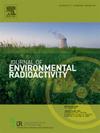Deep geological repositories — A review of design concepts, near-field evolution, and their implications for nuclear waste containment
IF 2.1
3区 环境科学与生态学
Q3 ENVIRONMENTAL SCIENCES
引用次数: 0
Abstract
Effective nuclear waste disposal is crucial for strengthening public confidence in nuclear energy as a cornerstone of sustainable, large-scale, carbon-neutral energy generation. Deep geological repositories (DGRs) provide the most viable long-term solution, employing a multi-barrier isolation system that inhibits radionuclide release and migration through a combination of engineered and natural barriers. While extensive research has focused on radionuclide transport mechanisms and the influence of geochemical interactions within host rock formations, a comprehensive understanding of the near-field environment, its physicochemical evolution, and its implications for repository design and nuclear waste management decisions remains underexplored. This review critically examines DGR concepts, near-field components, and processes, with a particular focus on canister-bentonite interactions, corrosion evolution, bentonite self-sealing mechanisms, and hydrogen gas generation. A critical assessment of experimental, numerical, and full-scale studies, highlights the complexities of coupled thermal, hydraulic, mechanical, and chemical (THMC) processes that govern repository evolution. Key challenges include scaling laboratory findings to field-scale repository conditions, integrating microbial and radiation-driven interactions, and refining long-term predictive models for corrosion and radionuclide migration. Addressing these gaps is critical for advancing repository safety assessments, optimizing engineered barrier systems, and ensuring the long-term stability of nuclear waste disposal strategies. These insights are expected to contribute to the ongoing development of robust and globally implementable waste management solutions, reinforcing nuclear energy’s role in climate change mitigation and the transition to a net-zero carbon economy.
深层地质储存库。设计概念、近场演变及其对核废料密封的影响的回顾
有效的核废料处理对于增强公众对核能的信心至关重要,核能是可持续、大规模、碳中和能源生产的基石。深层地质储存库(dgr)提供了最可行的长期解决方案,采用多屏障隔离系统,通过工程和自然屏障的结合,抑制放射性核素的释放和迁移。虽然广泛的研究集中于放射性核素运输机制和宿主岩层内地球化学相互作用的影响,但对近场环境、其物理化学演变及其对储存库设计和核废料管理决策的影响的全面了解仍未得到充分探索。这篇综述对DGR的概念、近场成分和工艺进行了批判性的研究,特别关注罐-膨润土的相互作用、腐蚀演变、膨润土的自密封机制和氢气的产生。对实验、数值和全面研究的关键评估,强调了控制储存库演变的耦合热、水力、机械和化学(THMC)过程的复杂性。关键的挑战包括将实验室研究结果与现场规模的储存库条件相结合,整合微生物和辐射驱动的相互作用,以及完善腐蚀和放射性核素迁移的长期预测模型。解决这些差距对于推进核废料处置库安全评估、优化工程屏障系统和确保核废料处置战略的长期稳定性至关重要。预计这些见解将有助于不断制定强有力的、全球可执行的废物管理解决方案,加强核能在减缓气候变化和向净零碳经济过渡中的作用。
本文章由计算机程序翻译,如有差异,请以英文原文为准。
求助全文
约1分钟内获得全文
求助全文
来源期刊

Journal of environmental radioactivity
环境科学-环境科学
CiteScore
4.70
自引率
13.00%
发文量
209
审稿时长
73 days
期刊介绍:
The Journal of Environmental Radioactivity provides a coherent international forum for publication of original research or review papers on any aspect of the occurrence of radioactivity in natural systems.
Relevant subject areas range from applications of environmental radionuclides as mechanistic or timescale tracers of natural processes to assessments of the radioecological or radiological effects of ambient radioactivity. Papers deal with naturally occurring nuclides or with those created and released by man through nuclear weapons manufacture and testing, energy production, fuel-cycle technology, etc. Reports on radioactivity in the oceans, sediments, rivers, lakes, groundwaters, soils, atmosphere and all divisions of the biosphere are welcomed, but these should not simply be of a monitoring nature unless the data are particularly innovative.
 求助内容:
求助内容: 应助结果提醒方式:
应助结果提醒方式:


